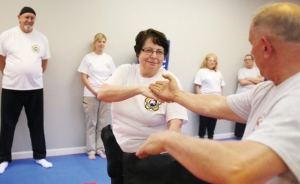The art of tai chi
By Becky Barclay
Published in News on February 19, 2017 12:48 AM

News-Argus/CASEY MOZINGO
Carol Hardison does a tai chi demonstration with instructor Eddie Brosseau that shows how the martial art can also be used as a self-defense technique. Ms. Hardison has been practicing tai chi for five years.
You start off holding the ball, then go into repulse monkey and brush knee, ending with golden rooster stands on one leg.
As strange as they sound, each of these moves is part of a tai chi form and one of the many that Eddie Brosseau teaches at his local Korean Martial Arts Academy.
Brosseau began practicing tai chi back in the 1980s while in Wichita, Kan. He practices tai chi chaun, which is more for health and exercise, being very low impact. He's been teaching tai chi about 10 years.
"It's very versatile for martial arts and health," he said. "If you actually translate tai chi from Chinese, it comes out 'ultimate boxing' and is a very effective martial art, a lot more than what it appears to be."
Brosseau said he uses a slow and methodical tai chi style.
"When you're practicing, you're thinking about the moves you're doing instead of the stress that you've had throughout the day," he said. "It's slow because of the precision. For example, instead of stepping, I'm going to place my foot. It's not hard on your joints this way.
"If I'm concentrating on my hands going a certain way or my foot stepping out a certain way while my hands are doing something, then I'm not thinking about that problem that I had at work today or that person who was aggravating me or the little things that affect everybody."
Anybody can do this form of tai chi, Brosseau said.
"I've had people with walkers that came and practiced," he said. Some people couldn't get out of their wheelchairs. They might just move their foot instead of stepping, and concentrate more on their hand movements. You can modify tai chi to your needs."
Anybody can get some benefit from tai chi, Brosseau said.
"You get a little bit of cardio," he said. "But you've got that continuous movement and concentration. You really feel it in your lower body when you practice tai chi. You really feel it in your glutes. You also feel it in your upper body because you're doing movements that you don't normally do."
Not only do you reap physical benefits from tai chi, but you also get some mental benefits from it. Because of the many moves involved, it helps your memory.
There are several forms, or sets, in tai chi, each with its own predetermined number of moves.
"We have some that have as few as 20 moves and some that may have more than 100 moves," Brosseau said. "A set on average lasts about a minute to three minutes. Each time you move a hand or a leg, you've done a move."
Brosseau usually starts his students off with the 10 form of tai chi, which has 10 different types of movements in it.
For those who don't have a lot of space in which to work, there is a also a form of tai chi they can do.
If you've got six to eight feet to work in, you can do this particular form," Brosseau said. "It was designed by Chinese dissidents who were being imprisoned so they'd be able to exercise."
Brosseau begins that form by raising his hands slowly and just letting them float up into the air, then dropping his elbows, letting his hands fall.
"This is when I establish how deep my stance is going to be throughout the form," he said. "Some beginners or an older person would not go down very deep. But a 20- or 30-year-old would bend their legs deeper. The deeper you go, the more you work your legs."
You go into repulse monkey, which Brosseau said, looks like a monkey swinging from limb to limb. Then it's holding the ball and brush knee, where you step out and your hand brushes by your knee.
There's also part the wild horse's mane.
"Imagine stroking the mane of a horse," Brosseau said. "That's the move."
Next comes wave hands like clouds and golden rooster stands on one leg.
Brosseau said it sometimes help to have mental picture of a move so you know why you do it.
"If I take part the wild horse's mane, think of it as a self-defense move," he said. "If somebody reaches for you, you grab their hand and strike. That's the move.
"All these moves in actuality are very effective martial art moves."
But Brosseau does them mostly as exercise and even a form of meditation.
He said tai chi is also good for balance.
"You start losing balance was you grow older, so we have to do something to compensate for that," Brosseau said.
So next time you're stressed or just want to work on your health and balance, grasp the swallow's tail or do snake creeps down the tree tai chi moves. Or you might even pretend you're a volcano and explode, sending your hands up and out like you're sending out cinders.
